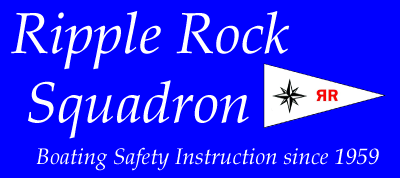Basic Introduction to the Collision Regulations
Caution:
- The following information has been simplified so we can give you a basic introduction using (mostly) non-technical language. Review the actual Regulations for in-depth information (we have noted the rule number, in square brackets, where practical). The Regulations can be found on our links page.
- A lot of effort has been made to ensure the information is correct, but errors may occur (If you find one please leave a message for our Webmaster).
- This information is intended for boaters on the BC Coast; it does not address modifications for vessels operating in the Great Lakes Basin.
We've all been in situations where we are walking towards someone, who is walking towards us. You swerve right, they swerve left, then you swerve left and they swerve right... Vessels turn and stop relatively slowly, so mariners need a more formal way of keeping out of each other's way. These rules are referred to as the Collision Regulations, Coll Regs or sometimes Rules of the Road..
We will start by deciding if there is a risk of collision, and then move on to what we need to do if there is a risk.
-
Risk of collision? - How do you decide?
- Yes, there is a risk of collision. Who does what? - not so basic (Restricted Visibility)
If you are the give way vessel (as discussed in Who does what), it is important that you take avoiding action early , and make the action visible to the stand on vessel (for example a major course change, about 30 degrees, not just 5 degrees), so they know you are obeying the rules [Rule 16]. If you are the stand on vessel, and the give way vessel does not give way, you must take action yourself if it becomes apparent that a collision cannot be avoided [Rule 17]. If the give way vessel finally takes action at the same time the stand on vessel decides they must take action, the situation could get very dangerous.
We have only covered some fairly simple situations above. For example, we have not dealt with 3 or more vessels meeting. In that case, the rules remain the same, but it takes more thought to figure out the interactions between vessels.
As a small pleasure craft operator, remember that even though the rules may consider a cruise ship or a freighter to be the same as you when it comes down to give way and stand on (outside of narrow channels and traffic separation schemes), it is prudent for you to stay out of their way. Large ships can take several miles to stop, and alter course relatively slowly compared to what can be done in a smaller vessel. If the houseworks are aft, particularly if they are loaded with containers or logs, they may not be able to see the water up to 1/2 mile ahead. With their better height of eye, and sophisticated equipment, they may be dealing with other collision risks you are not aware of. Give them a break by making it obvious you are staying out of their way.
The same consideration should also be given to towing vessels and their tows, but in this case there is an additional factor. Towlines are often made of wire. Their weight sinks them below the surface of the water. If you cut between a tug and its tow, you may get caught on the wire, stopping you, possibly capsizing your boat, and leaving you in a perfect position for the tow to run you over (even if the tug stops immediately, the barge will keep coming). Barges may also be trailing a "pick-up" line, to enable the tug to reconnect to its tow in rough water if the main towline breaks. The pick-up line may extend up to 100 meters behind the barge and floats, so it will be on the surface. There should be a buoy on the end, but it may be missing. If your boat's leg or prop gets caught on that line, again there is a good possibility you will be capsized. Always stay well clear of a tug and tow.
Navigation lights allow us to determine the size and course of another vessel at night or in restricted visibility. Special lights (and day shapes) are used to show special circumstances, such as towing, or at anchor.
- Navigation Lights - The Basics Power driven vessels, sailing vessels, under oars and vessels at anchor. All very common around Campbell River.
- Navigation Lights - Advanced Towing vessels, vessels under tow, diving and rescue/enforcement. Also very common around Campbell River.
- Navigation Lights - More advanced Fishing, Restricted in ability to Manoeuvre, Hovercraft, Pilot vessel. Not common around Campbell River but you may see them on a trip to Vancouver.
- Navigation Lights - Less Common Towing alongside, pushing ahead, dredging or underwater operations with obstruction, aground, constrained by draft and mine clearance. Not often seen around Campbell River but you may see them on a trip to Vancouver, with towing alongside and underwater operations quite likely in the Fraser River.
This ends our basic introduction to Collision Regulations. We have not covered all of the regulations here, but hope that this answers some of the questions you may have.
